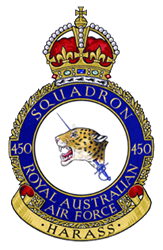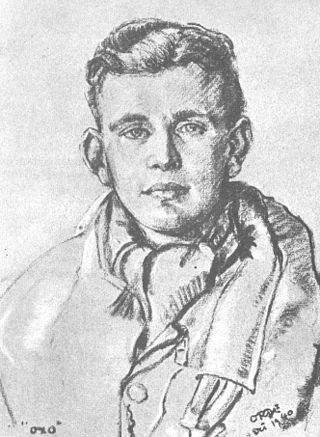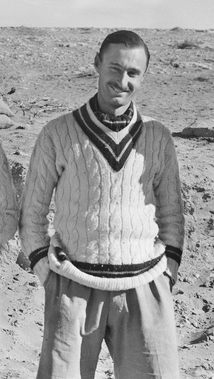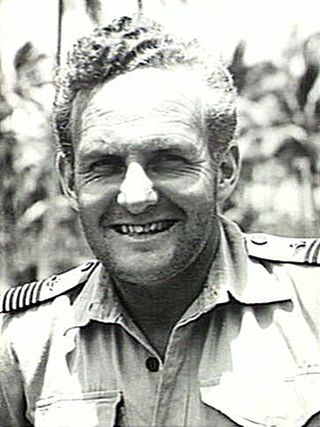Related Research Articles

Air Commodore Arthur Henry Cobby, was an Australian military aviator. He was the leading fighter ace of the Australian Flying Corps (AFC) during World War I, despite seeing active service for less than a year.

No. 450 Squadron was a unit of the Royal Australian Air Force (RAAF) that operated during World War II. Established at RAAF Station Williamtown, New South Wales, in February 1941, it was the first Australian Article XV squadron formed under the Empire Air Training Scheme.

No. 22 Squadron is a Royal Australian Air Force (RAAF) mixed Permanent and Reserve squadron that provides support for the RAAF in the Sydney region. Formed in 1936, the squadron served in Papua New Guinea during the Second World War, and later followed the Pacific War as far as the Philippines. Following the war, the squadron was re-formed in 1948 but was converted to a non-flying support role in mid-1960. It is currently based at RAAF Base Richmond, New South Wales.

Andrew William "Nicky" Barr, was a member of the Australian national rugby union team, who became a fighter ace in the Royal Australian Air Force (RAAF) during World War II. He was credited with 12 aerial victories, all scored flying the Curtiss P-40 fighter. Born in New Zealand, Barr was raised in Victoria and first represented the state in rugby in 1936. Selected to play for Australia in the United Kingdom in 1939, he had just arrived in England when the tour was cancelled following the outbreak of war. He joined the RAAF in 1940 and was posted to North Africa with No. 3 Squadron in September 1941. The squadron's highest-scoring ace, he attained his first three victories in the P-40 Tomahawk and the remainder in the P-40 Kittyhawk.

No. 466 Squadron RAAF was a Royal Australian Air Force (RAAF) bomber squadron during World War II. Formed in the United Kingdom in late 1942, the squadron undertook combat operations in Europe until the end of the war, flying heavy bomber aircraft. Following the conclusion of hostilities with Germany, the squadron began retraining to undertake operations in the Pacific against the Japanese, but the war came to an end before it left the UK. In late 1945, the squadron was disbanded.

Robert Henry Maxwell Gibbes, was an Australian fighter ace of World War II, and the longest-serving wartime commanding officer of No. 3 Squadron RAAF. He was officially credited with 10¼ aerial victories, although his score is often reported as 12, including two shared; Gibbes was also credited with five aircraft probably destroyed, and a further 16 damaged. He commanded No. 3 Squadron in North Africa from February 1942 to April 1943, apart from a brief period when he was wounded.
No. 1 Fighter Sector (1FS) was a Royal Australian Air Force (RAAF) unit formed at Bankstown, New South Wales on 25 February 1942.

Squadron Leader John Edwin Ashley "Willy" Williams was an Australian air ace during the Second World War. He served in the Middle East and North Africa with the Royal Air Force (RAF), and was among the Allied prisoners of war (POWs) murdered by the Gestapo following "The Great Escape" in 1944. He commanded No. 450 Squadron of the Royal Australian Air Force for three days, before he was captured in 1942.

Wing Commander Michael Nicholson Crossley, was a Royal Air Force flying ace who, during the Second World War, led No. 32 Squadron RAF in the Battle of Britain. Crossley shot down 20 enemy aircraft and shared in the destruction of two others with one 'probable' and one 'damaged'. All of his victories were scored in the Hawker Hurricane.

Air Vice Marshal Henry Neilson Wrigley, CBE, DFC, AFC was a senior commander in the Royal Australian Air Force (RAAF). A pioneering flyer and aviation scholar, he piloted the first trans-Australia flight from Melbourne to Darwin in 1919, and afterwards laid the groundwork for the RAAF's air power doctrine. During World War I, Wrigley joined the Australian Flying Corps and saw combat with No. 3 Squadron on the Western Front, earning the Distinguished Flying Cross; he later commanded the unit and published a history of its wartime exploits. He was awarded the Air Force Cross for his 1919 cross-country flight.

Harry George Smart, is best known for having been the commander of RAF Habbaniya during the first part of the Anglo-Iraqi War. Smart was an officer in the British Army, the Royal Flying Corps and the Royal Air Force. He served during the First World War, during the interwar period, and during the Second World War.

Robert Wardlow Oxspring, was a Royal Air Force officer and flying ace of the Second World War.

Air Commodore Gordon Henry Steege, DSO, DFC was a senior officer and pilot in the Royal Australian Air Force (RAAF). He became a fighter ace in World War II, credited with eight aerial victories, and led combat formations at squadron and wing level.

Peter Jeffrey, was a senior officer and fighter ace in the Royal Australian Air Force (RAAF). Born in Tenterfield, New South Wales, he joined the RAAF active reserve in 1934, and transferred to the Permanent Air Force (PAF) shortly before World War II. Posted to the Middle East in July 1940, Jeffrey saw action with No. 3 Squadron and took command of the unit the following year, earning the Distinguished Flying Cross for his energy and fighting skills. He was appointed wing leader of No. 234 Wing RAF in November 1941, and became an ace the same month with his fifth solo victory. The next month he was awarded the Distinguished Service Order for his achievements, which included rescuing a fellow pilot who had crash landed in the desert.

John Raeburn Balmer, was a senior officer and bomber pilot in the Royal Australian Air Force (RAAF). Born in Bendigo, Victoria, he studied law before joining the RAAF as an air cadet in 1932. An instructor at Point Cook from 1935 to 1937, he achieved renown in Air Force circles when he reportedly parachuted from a training aircraft to motivate his pupil to land single-handedly. He also became known to the general public as a cross-country motorist, setting records for trans-Australia and round-Australia trips before World War II.
The King's Birthday Honours 1945, celebrating the official birthday of King George VI, were announced on 14 June 1945 for the United Kingdom and British Empire.

Commando was a very long range Consolidated Liberator II aircraft adapted for passenger transport, to serve as the personal aircraft of Prime Minister Winston Churchill. Commando disappeared without a trace on 27 March 1945 over the North Atlantic Ocean, while on a flight from RAF Northolt to Lajes Field in the Azores, en route to Ottawa in Canada. The cause of the disappearance of the aircraft remains unknown to this day.

Alan Charles Rawlinson, was an Australian airman who became a fighter ace in World War II. He was credited with at least eight aerial victories, as well as two aircraft probably destroyed, and another eight damaged.
The 1944 King's Birthday Honours, celebrating the official birthday of King George VI, were announced on 2 June 1944 for the United Kingdom and British Empire, New Zealand, and South Africa.

Hugo Throssell Armstrong was an Australian flying ace of the Royal Australian Air Force (RAAF) during the Second World War. He was credited with at least ten aerial victories.
References
- ↑ Shores, C; Williams C. Aces High: A Tribute to the Most Notable Fighter Pilots. Grub Street. p. 101. ISBN 1-898697-00-0.
- ↑ "Barber's biography". Ciel de Gloire. Ciel de Gloire. 15 November 2015. Retrieved 15 November 2015.
- 1 2 "Barber's awards". TracesOfWar.com . TracesOfWar.com. 15 November 2015. Retrieved 15 November 2015.
- ↑ "No. 42688". The London Gazette (Supplement). 25 May 1962. p. 4358.